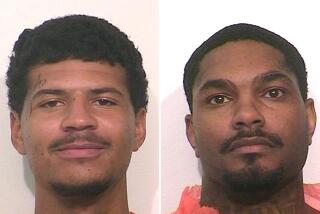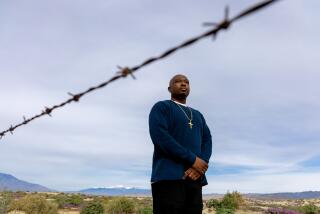Manson and ‘Night Stalker’ murderers and California justice
The cases of two convicted murderers, within the space of 48 hours, made it clear that California’s handling of capital cases may need a wee bit of tweaking.
On Friday, death row inmate Richard Ramirez died. He was the notorious “Night Stalker,” convicted of killing 13 people and trying to kill five others and of 11 counts of sexual assault. He had spent more than half his life behind bars, mostly on death row; he died in a hospital bed in Marin County.
In November, Proposition 34 on the California ballot would have abolished the death penalty. It lost, 48% to 52%. Death row inmates can’t vote, of course, but paradoxically, some percentage of California’s 725 death row inmates were against the measure, it was reported.
The reasoning went that the end of the death penalty would also mean an end to their fairly broad legal privileges for appealing their convictions. More cynical commentators surmised that the death row denizens calculated the prospect of execution, given that California hasn’t executed anyone in more than seven years, versus the perks that the condemned get: phone privileges, space for voluminous legal files, solo cells, and they’re in charge of the TV channel changers.
The death penalty is much more expensive in California than life in prison without parole -- about $184 million a year more. A three-year study found that each execution costs the state nearly a third of a billion dollars. Billion, with a “b.”
Death penalty economics, compounded with concerns about the possible factual innocence of death row inmates, explains the mend-it-or-end-it reasoning that has shifted attitudes in California, although not enough to push the anti-death penalty measure over the 50% mark last November. And Ramirez is the gruesome poster boy for death penalty supporters, who argue that if ever anyone deserved to be executed, it was the Night Stalker.
Two days before Ramirez died, a former death row inmate named Leslie Van Houten had her 20th parole hearing. She was turned down, again.
Had TV cameras been allowed into the hearing, they would have shown Van Houten as gray-haired and wrinkled and looking older than her 63 years. She was a 19-year-old follower of Charles Manson when she and her cohorts murdered Leno and Rosemary LaBianca in their Los Feliz home in August 1969.
She and two other “Manson girls,” as well as Manson himself, were convicted together and sentenced to death. A sweeping state Supreme Court ruling overturning death sentences changed hers automatically to life with the possibility of parole.
For years, Van Houten has been regarded as the Manson member with the best prospects for parole, given her prison work and record, and the fact that, as at earlier parole hearings, a number of people wrote letters on her behalf, offering to care for and shelter the Altadena native. LaBianca relatives, who were there for the eight-hour hearing, said that Van Houten was still a danger to society.
The two parole commissioners turned down Van Houten’s parole request because of the “heinous and atrocious” nature of the murders.
“The crimes will always be a factor,” said Board of Parole Hearings Commissioner Jeffrey Ferguson, a former Oakland police officer (half of the current parole board commissioners are former law enforcement officers). “The question is whether the good will ever outweigh the bad. It certainly didn’t today.”
State law requires the parole board to set a release date for a prisoner unless, as the law says, “it determines that the gravity of the crime (offense), or the timing and gravity of current or past convictions, requires a more lengthy period of incarceration to ensure public safety.”
The panel is supposed to take into consideration “counseling reports and psychological evaluations; behavior in prison; vocational and educational accomplishments in prison; involvement in self-help therapy programs” and parole plans.
The California Supreme Court in January 2005 ruled that in denying parole suitability, “the overriding statutory concern for public safety” outweighs any comparison with other inmates with similar crimes. With that standard in mind, the board doesn’t even have to set a possible parole date if it “reasonably believes that the gravity” of the crime “indicates a continuing danger to the public,” the court declared.
But to find an inmate unfit for parole based on the circumstances of the crime, the court continued, the parole board has to “cite some evidence of aggravating facts beyond the minimum elements of the crime.”
If Van Houten hadn’t been associated with Manson but still had joined in the equally vicious murders of two people, would she be free today, or any closer to freedom?
Other murderers who have killed more people than Van Houten may be more readily paroled than she. She is among a group of high-profile killers -- like Manson himself, or Robert F. Kennedy’s assassin, Sirhan B. Sirhan -- whose crimes are so notorious that the stigma attached to them means they will never be paroled. Governors appoint parole board commissioners, and the prop-wash to them for the parole of killers like Van Houten could be politically costly.
Van Houten is eligible for parole again in 2018, nearly 50 years after the murders. That’s one, maybe two gubernatorial elections away.
ALSO:
Keep calm and let the NSA carry on
Gay rights, and why marriage matters so much
More to Read
A cure for the common opinion
Get thought-provoking perspectives with our weekly newsletter.
You may occasionally receive promotional content from the Los Angeles Times.










